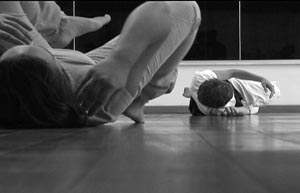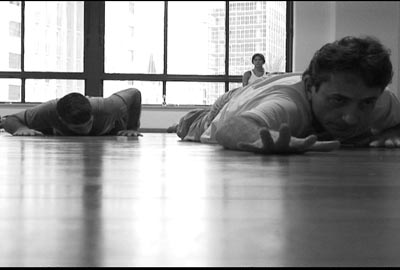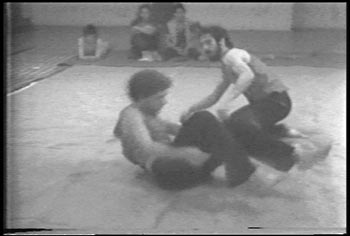What is Release Technique?
by: Daniel Lepkoff
June 1999
Published in: The Movement Research Performance Journal Fall/Winter 1999 #19
My understanding of Release Technique originates from my experiences as a student of Mary Fulkerson, with whom I studied intensively between the years of 1970 - 1974. Mary Fulkerson referred to her work as "Anatomical Release Technique". During these early years I also studied with John Rolland and Marsha Paludan, I worked with Nancy Topf and Pamela Matt, and I visited Barbara Clark.
Mary's view was that in order to change habitual movement patterns one needed to address the functioning of the whole organism, the mind as well as the body. The basic method of effecting change in the body was designed with the following idea in mind: by the time an intention has become realized in a physical action, it is too late to alter how this action is played out. The seed of an action is embedded somewhere between the forming of an intention and the subsequent launch into action. This seed is the body's "image" for the action. For example, if you are sitting in a chair and the telephone rings from across the room, your body, before it can actually stand up and answer the phone needs to ready itself. The details of this preparation are based upon the body's expectation of what will be required to fulfill the ensuing task. These details may include re-aligning the skeleton, stabilizing certain body parts and freeing others, shifting the body's center of weight, as well as changes in the body's chemistry, and more. This physical preparation is what I understand as the body's image. It is this image which determines the specific organization of the ensuing action. Release work attempts to bring consciousness to bear on the subtle process of how we bring ourselves into motion. Anatomical observations were used to construct and propose verbal or pictorial images for physical actions.

In Mary's classes we worked with developmental movement as the source of a basic vocabulary. We studied and practiced rolling, crawling, walking, running, falling, and the transitions between these patterns. Mary had a system of anatomically based images that mapped out functional pathways through the architecture of the body.
Up the front of the spine to the base of the neck, through the spine and up the back of the skull, down the face, through the spine again and down the back to the sacrum, around the outside of both halves of the pelvis, down the outside of the legs, down the top and outside of the feet, up the inside of the feet, up the inside of the legs, through the hips joint, up the front of the spine, and so on. These pathways indicated structurally sound lines of compression and support, and channels of sequential flow of action at work in the underlying developmental patterns. These images were considered to be ever more refinable once we were ready to perceive in finer detail.

Photos: Lepkoff workshop, Sao Paulo, Brasil, 2008
Photographer: anonymous
An important aim of the technical work in Mary's Release classes was to draw the body closer to channeling its action along these pathways. This would both re-align the body so that weight was supported through the center of the bones as well as re-pattern the flow of energy so that action was initialed by the muscles closest to the bodies center. This shift would release the
outer muscles of the body from holding weight and free them for what they were meant to do, namely move the body. This was one reason the work is called "Release Technique"
The Constructive Rest Position was used as one of the prime positions for receiving and responding to new physical images. In the constructive rest position it is possible to release most muscular activity and not fall. This physical state of near-total release is thought to be one relatively free of preconceived images and thus a state in which the body is most receptive to the suggestion of alternate physical images. An action can be imagined and not executed, thus stimulating and consciously re-patterning the body's response to an intention to move. Releasing is not simply release of excess muscular tension but releasing deep physical pre-conceptions as well.
The practical subtleties of imagining an action and not doing it, of allowing an image to move you rather than moving yourself, were both physically and conceptually challenging. The concept of "not-doing" as an activity that one could "do!" was new, fascinating, and sometimes confusion. How to use ones energy when the act of "doing" would initiate the very response one was trying to alter was sometimes frustrating and disorienting. However, these physical practices nurtured in me a remarkably fine tuned ability to listen to my body and to my mind. I also experienced how the specific physical images I was integrating into the overall sense of my body translated into a facility to move in new ways. I still remember the thrill of learning to spin, to leap and turn without falling over. The key was the image of "the center line" and viewing spinning as an extension of the underlying action of walking.

Daniel Lepkoff & Steve Paxton, Contact Improvisation, L'Attico Gallery, Roma, Italy, 1973
From video by: Steve Christiansen
After immersing myself in Mary's work for about one year I encountered Steve Paxton's work with Contact Improvisation. This gave me an alternate view on my work with anatomical images. Steve's work also addressed the presence of mind in the body with a subtle yet important difference. In Contact Improvisation the mind is used as a lens and is
cultivated for its powers of alertness and observation. Steve's exercises and verbal images focused my attention directly on physical sensation rather than associative concepts or idealizations of physical actions. I remember remarkable times of unleashed expression of energy in my Release classes, however, Contact Improvisation regularly exposed my body to higher levels of physical stimulation. While release classes felt like a fine meal of carefully chosen morsels, Contact Improvisation was often like a bacchanalian feast.
Steve Paxton's work with Contact Improvisation gave me new insights into my internal process of working with an image in release class and exposed some potential pitfalls. The anatomical images Mary used ("up the front, down the back", "swing the legs from high in the sternum") served as maps for seeking and interpreting physical actions. The verbal description of an image is only a symbol for an actual physical action, just as a road map is only a symbol for an actual location. I felt if I identified too literally with an image without a visceral link to my physical sensations I could in a sense "brainwash" my body.
In my desire to succeed in allowing an image to move me and in the face of the daunting subtleties of this task, I could convince myself that I was indeed feeling "my head lead my spine", for example, when in fact I was not. The image could actually come between me and my body, a disembodied image.
The flip side of my awareness that I could fool myself in the process of working with an image was a growing recognition of what it really did feel like to "feel" my body. I was recalibrating my scales; expanding my abilities to sense; widening my notions of what a physical sensation could be. I realized that the technique of "not-doing" was only a ploy to coax me to look for what I could not see (yet!), to listen for what I could not hear (yet!). I realized that the words used to describe a physical image were often too gross, that the body's concepts are more sophisticated and detailed than those of the English language. One needed a sense of play to avoid holding to fixed interpretations of verbal images and thus limiting ones physical experience. Sensory feedback from the body was essential to open to new images.
The physical demands of a Contact Improvisation duet, the intensity of weight, force, and need for instantaneous response also exposed limitations in the loose jointed soft quality I had developed through my release work. While my released softness made me particularly receptive to the streaming flow of sensations in a Contact duet, it did not set me up to harness the power, strength, and speed I needed to play freely with a full range. In my own work I've realized that "release" as a physical principle is only one part of a more complete description of the functioning of the body.
My early work with Release Technique did more than help develop an integrated, intelligent, and healthy body. I developed an appetite for focusing on physical sensation, an ability to teach myself, and a love for the renegade, mysterious, and insightful interplay of the imagination, mind, and the act of dancing.
Comment:
Mary Fulkerson, John Rolland, Marsha Paludan, Nancy Topf, Pamela Matt and Barbara Clark as well as Joan Skinner, all of whom knew each other, were among a few who in the early '70's were cross pollinating ideas and visions, in a process of developing Release Technique as an alternative dance technique. John Rolland wrote a practical manual, "Inside Motion: An Ideokinetic Basis for Movement Education" and Pamela Matt wrote a book detailing the work of Barbara Clark, "A Kinesthetic Legacy: The Life and Works of Barbara Clark". Both of these publications are available through Contact Editions
Daniel Lepkoff
Comment: If one is seeking the most accurate description of what happens when we move; then ultimately I think the best encoding of that information is held in our muscle memories. Rather than think of information as something that must be expressed in a written, spoken, or pictoral language, why not consider that experience itself is the most finely tuned language holding our knowledge of how to survive, that the most accurate images of how to move are to be found within our intelligent interactions with the environment itself. The best description of something is the thing itself.
Daniel Lepkoff